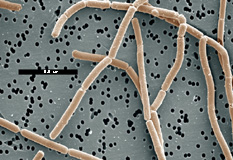Lactobacillus delbrueckii: Difference between revisions
imported>Kiran A. Bharwani No edit summary |
imported>Kiran A. Bharwani No edit summary |
||
| Line 57: | Line 57: | ||
==Application to Biotechnology== | ==Application to Biotechnology== | ||
Does this organism produce any useful compounds or enzymes? What are they and how are they used? | Does this organism produce any useful compounds or enzymes? What are they and how are they used? | ||
Two subspecies of Lactobacillus delbrueckii, L. delbrueckii bulgaricus and L. delbrueckii lactis play a major role in the dairy industry. Fermented yogurt, milk, and cheese are cultured from these two subspecies. If the process of fermentation that occurs through L. delbrueckii bulgaricus and L. delbrueckii lactis came to a halt it would result in a large economic loss. This is why care must be taken to keep the conditions of production constant. | |||
==Current Research== | ==Current Research== | ||
Revision as of 14:17, 2 April 2008
Articles that lack this notice, including many Eduzendium ones, welcome your collaboration! |
| Lactobacillus delbrueckii | ||||||||||||||
|---|---|---|---|---|---|---|---|---|---|---|---|---|---|---|
| [[image: | ]] | |||||||||||||
| Scientific classification | ||||||||||||||
|
Classification
Higher order taxa
Domain: Bacteria; Phylum: Firmicutes; Class: Bacilli; Order: Lactobacillales; Family: Lactobacillaceae
Species
L. delbrueckii
Description and significance
L. delbrueckii is a gram positive bacteria. It is long, filamentous and non-motile. The environment in which L. delbrueckii thrives the most would be one of relatively low pH, preferring acidic enviornments. L. delbrueckii undergoes obligate homofermtentative metabolism which means they are only able to ferment lactose and no other sugar. In addition, they can able to survive in an environment which has oxygen present.
In 1905, Stamen Grigoroy, a Bulgarian doctor, discovered L. delbrueckii...
Include a picture or two (with sources) if you can find them.
Genome structure
Describe the size and content of the genome. How many chromosomes? Circular or linear? Other interesting features? What is known about its sequence? Does it have any plasmids? Are they important to the organism's lifestyle?
Cell structure and metabolism
Describe any interesting features and/or cell structures; how it gains energy; what important molecules it produces.
Ecology
Describe any interactions with other organisms (included eukaryotes), contributions to the environment, effect on environment, etc.
Pathology
Unlike most microbes, L. delbrueckii is non-pathogenic. It is the source that provides milk, yogurt, cheese, and vegetables.
Application to Biotechnology
Does this organism produce any useful compounds or enzymes? What are they and how are they used?
Two subspecies of Lactobacillus delbrueckii, L. delbrueckii bulgaricus and L. delbrueckii lactis play a major role in the dairy industry. Fermented yogurt, milk, and cheese are cultured from these two subspecies. If the process of fermentation that occurs through L. delbrueckii bulgaricus and L. delbrueckii lactis came to a halt it would result in a large economic loss. This is why care must be taken to keep the conditions of production constant.
Current Research
Enter summaries of the most recent research here--at least three required
References
